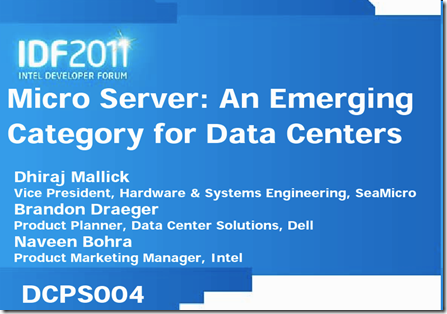There has been a bunch of press on Seamicro's latest SM1000 product. The press release is here.
SeaMicro Introduces the SM10000-64HD, Setting Industry Record for Energy Efficiency and Compute Density
July 17, 2011

With 384 Intel® Atom™ Dual-core 1.66 GHz Processors; 768 64-bit Cores and 1,275 GHz in a 10 Rack Unit System
SUNNYVALE, Calif., July 18, 2011 – SeaMicro™, the Silicon Valley pioneer of low power server technology, today announced the immediate availability of the world’s most energy efficient 64-bit x86 server: the SM10000-64HD™. SeaMicro has once again defined best in class by improving its own compute density record by 150 percent and increasing its own industry leading compute per-watt metric by 20 percent. The new SM10000-64HD replaces 60 traditional servers, four top of rack switches, four terminal servers and a load balancer while using one-fourth the power and taking one-sixth space—all without requiring any changes to software.
I have been talking to a couple of people who have hands on experience with the Seamicro boxes. One way to think about the Seamicro box is as if it is different type of mainframe.
Mainframes are designed to handle very high volume input and output (I/O) and emphasize throughput computing. Since the mid-1960s, mainframe designs have included several subsidiary computers (called channels or peripheral processors) which manage the I/O devices, leaving the CPU free to deal only with high-speed memory. It is common in mainframe shops to deal with massive databases and files. Gigabyte to terabyte-size record files are not unusual.[5] Compared to a typical PC, mainframes commonly have hundreds to thousands of times as much data storage online, and can access it much faster.[citation needed] Other server families also offload I/O processing and emphasize throughput computing.
Thanks the processor and high volume server wars, the data center in dominated by Intel Xeon based servers typically running in 2 processor configuration. Few 4, 8, 16 processor configurations are sold. For Big Iron for Amazon.com and eBay type of loads there are the Sun Servers for big Oracle databases, but Sun no longer has the presence in data centers it used to.
SPARC Enterprise M9000 Server
Oracle's most scalable mission-critical server for the largest, most demanding workloads
Designed for mission-critical environments, Oracle's SPARC Enterprise M9000 server delivers massive scalability, with up to 64 processors and 256 cores for the most demanding virtualization, consolidation, and multi-hosting deployments.

Now the problem with a mainframe metaphor is mainframes are considered dying, but look how IBM has extended the life of the mainframe.
The safe thing to do for a Web 2.0 company is to continue down the path of low cost dual processor servers, networked with top of rack gigabit switches.
Even though some look at Seamicro in terms of the Intel Atom processor, I pay more attention to how Seamicro is solving the IO and networking issues that are typical bottlenecks for throughput. Consider this job posting at Seamicro.
SeaMicro is looking for an experienced Senior Hardware Design Engineer to architect and implement a flexible and scalable networking solution for its next generation data center products. This is an excellent opportunity for high-energy candidates who can take a complex networking solution from conception, through execution, to first customer shipment.
Qualifications:
- 10+ years of experience in high-performance/high-bandwidth micro-architecture
- 10+ years of experience in Verilog RTL development, with some experience in design/development of networking chips
- Experience with designs based on network processors, 10G interfaces, and DDR memory controllers desirable
- Solid understanding of L2 Ethernet switching protocols including VLAN, Broadcast/Multicast, and LACP is a plus
- Working knowledge of IPv4, IPv6, ACLs, and QOS











